Meet the 2016 Gold Cup finalists
The shortlist has been announced for the NMR/RABDF Gold Cup and the winner will be revealed at the Livestock Event on 6 July.
We talk to the dairy farmers who have made the selection to find out about their businesses and why they’ve been shortlisted.
See also: Neil Baker wins the 2015 Gold Cup
Brian, Sheila and Michael Yates, East Logan, Castle Douglas, Kirkcudbrightshire
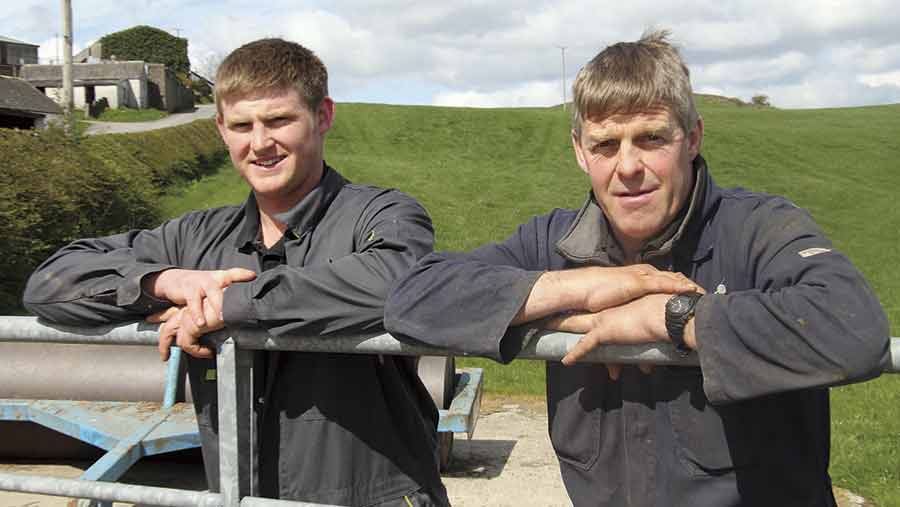
Brian Yates (right) with son Michael ©Drew Geddes
This it the third time the Yates family has qualified and entered the competition with their 280-cow Logan herd, which is based on a 137ha unit at East Logan.
Housed all year and fed a TMR, the herd’s average production, for the year ending September 2015, was 12,273kg at 3.83% butterfat and 3.09% protein, with 102,000 cells/ml.
Impressive yields are fuelled by feeding a consistent ration that is monitored daily and changes can be implemented on farm and, if required, remotely.
The in-calf rate 100-days post calving stands at an impressive 53% in this all-year-round calving herd and the mastitis rate for the herd is just 10 cases a 100 cows, with an average cell count of 85,000 cells/ml for the past 10 months.
The target is lifetime yields of at least 50,000kg of milk across five lactations and cows that live long and productive lives in a cubicle-based dairy system. Milk is sold to Arla.
Richard and Grant Walker, Lakehead Farm, Thornhill, Dumfriesshire
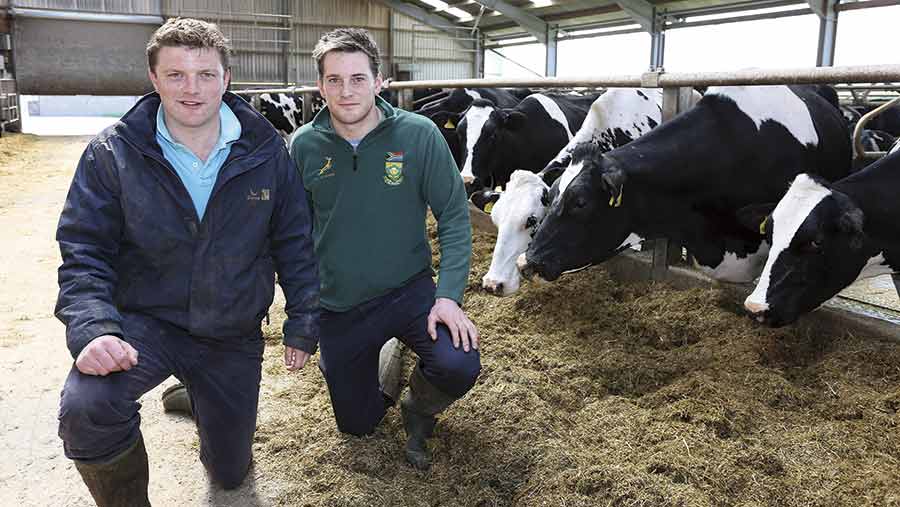
Richard (left) and Grant Walker
Richard and Grant Walker farm in partnership with their mother Shona and together they run a pedigee Holstein Friesian herd of 515 cows plus 405 followers on their 329ha grass and arable unit.
Over the past four years, since the brothers returned from university, there has been substantial investment in farm infrastructure and the herd has increased threefold.
A young team of seven – with an average age of 24 years – look after the herd which averaged 10,575kg of milk at 3.88% fat and 3.33% protein on a flat rate TMR system. Yield average is now above 11,000kg.
Rations are formulated to minimise body condition loss in early lactation so cows get back in calf quickly and it also reduces the risk of metabolic disorders and other health issues.
Combined with good heat detection, they achieve an impressive 62% of cows in calf at 100 days and have a current calving interval of 382-days. Milk is sold to Muller Wiseman’s Co-op Dairy Group.
See also: Gold Cup winner reveals how recording can cut mastitis and lameness
David Irwin, The Beeches, Dungannon, Co Tyrone
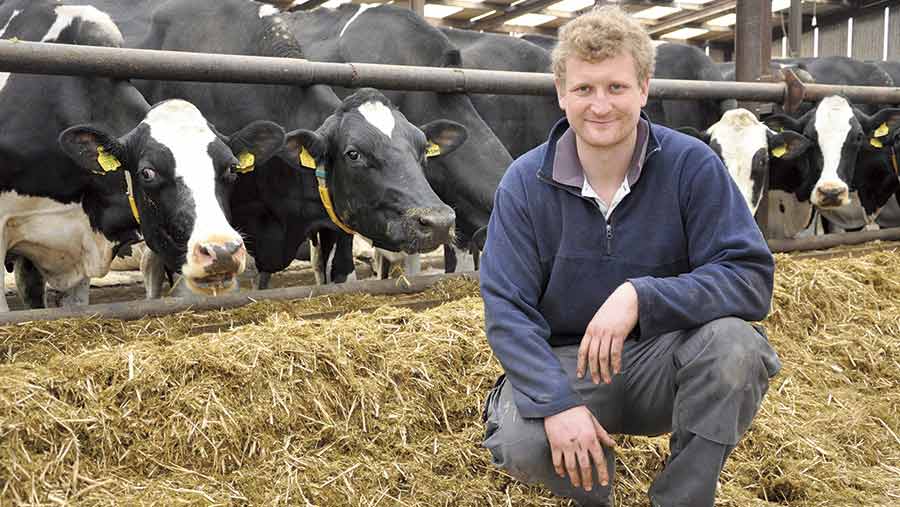
David Irwin © Chris McCullough
David Irwin farms in partnership with his parents David and Sylvia and along with two full time staff they run the pedigree Redhouse Holstein herd of 170 autumn/winter calving cows plus followers.
The 93ha unit is mainly consists of grass with 20ha of spring barley grown for inclusion in the dairy rations. The milking herd is fully housed and averages 12,300kg milk at 3.84% fat and 3.21% protein on three times a day milking.
David not only runs a high yielding, high health status herd – that is accredited Johne’s and BVD free – but has also built up an enviable reputation for selling high-quality breeding stock which is worth in excess of 5ppl to his business.
David is an early adopter of technology and husbandry techniques and has recently invested in a host of technology and gadgets to improve herd performance, including a heat detection system to improve submission rates to AI and triangular vented liners in the milking clusters to improve teat end condition.
The Irwins have also invested heavily in an extra 600,000gal (2.7m litres) of slurry storage facilities to comply with NVZ rules and to allow more timely slurry application.
Milk is sold to Fane Valley Co-Op.
Tomos Davies, Rhydygors Farm, Talog, Carmarthen
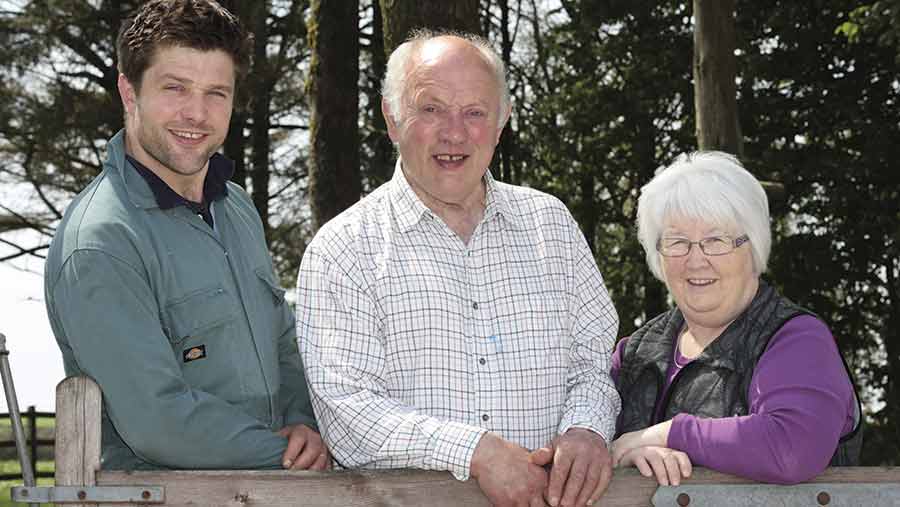
Tomos Davies with mum Myrtle and Dad Glyn
Tomos Davies farms in partnership with his father Glyn and mother Myrtle and runs 325 milkers, plus 230 youngstock.
Housed all year round and fed a TMR, the Holstein herd’s average production, for the year ending September 2015, was 12,109kg at 3.92% butterfat and 3.21% protein, with a somatic cell count of 191,000cells/ml.
Yields have increased during the past few years due to consistent feeding and a switch to three-times-a-day milking that saw milk yields rise by 20% in cows and 30% in heifers.
This meant they could increase output from their 80ha and 65ha of rented land.
The herd’s TMR comprises grass silage, a custom blend, caustic-treated wheat, fat, minerals and buffers. All cows are fed the same ration and just 1kg of concentrate is fed each milking.
At 265m above sea-level grass silage is the only forage option. Fertility is also improving with calving interval reducing by 14 days in 12 months to 406 days.
The target is 390 days. Mastitis rate is just 16 cases a 100 cows and all animals on the unit are tested for BVD and Johne’s disease. Milk is sold to Muller Direct Milk.
Adrian McFarland, 41 Backfarm Road, Omagh, Co Tyrone
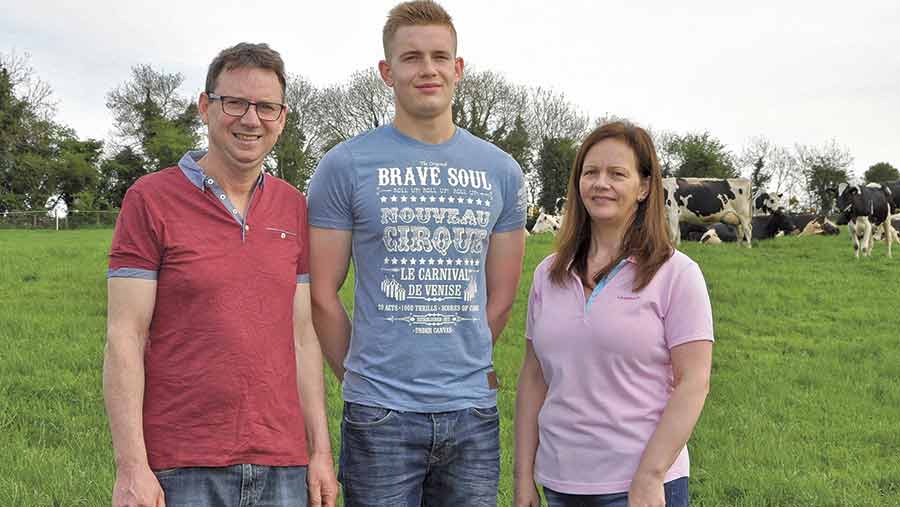
Adrian, Ryan and Sharon MacFarland © Chris McCullough
Adrian farms in partnership with his wife Sharon and they have been joined on the farm part-time by their eldest son Ryan, who has recently finished his university studies.
Together they run a herd of 106 Holstein Friesian cows plus 44 followers on their 64ha farm and they strive to be as technically efficient as possible.
The herd calves from September to March and is TMR and parlour-fed in winter and grazed in summer to produce an average 8,069kg milk at 4.2% fat and 3.28% protein, with an SCC of 101,000 cells/ml.
High annual rainfall in excess of 1,300mm makes grazing challenging and forage making conditions difficult, but they have bought their own forage wagon so they can take advantage of the few dry windows in the season to make high-quality silage.
They have also focused heavily on improving soil fertility through extensive sampling and targeted use of fertiliser to optimise grass growth and quality. The target is a forage yield of 18t DM/ha.
A combination of high D-value grass silage and well-managed strip grazing means the herd is averaging 1,835 litres of milk from forage a cow (3,443 litres/ha) which is an improvement of 800 litres a cow in just 12 months.
They have an extensive vaccination programme for Leptospirosis, BVD and IBR as well and routinely monitor for Johne’s through NMR‘s Herdwise scheme. Mastits rate is impressive – at eight cases a 100 cows and 55% of cows are in calf by 100-days post calving. Milk is sold to United Dairy Farmers.
Simon Bugler, Pilsdon Dairy Farm, Bridport, Dorset
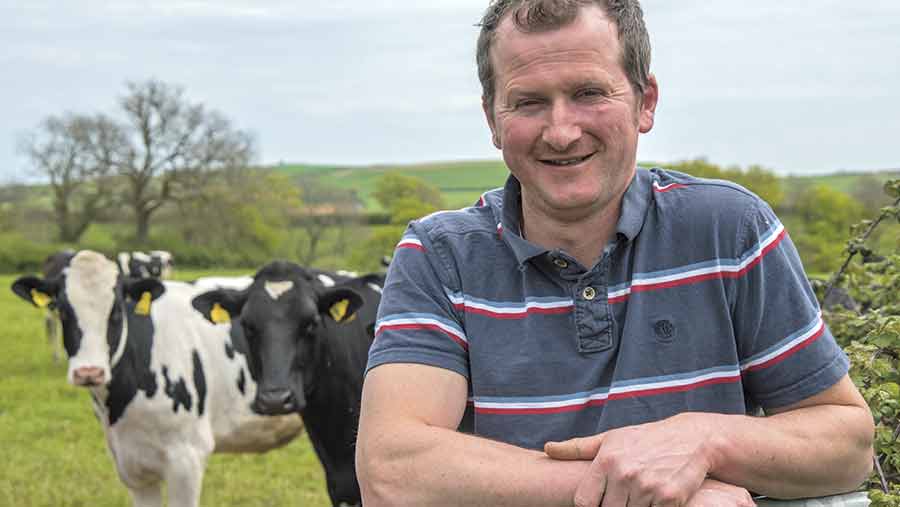
Simon Bugler
Simon Bugler runs Pilsdon Dairy Farm with his parents Roland and Heather.
Together with 12 full-time employees they manage the high-yielding herd of 570 pedigree Holsteins plus 700 followers on 295ha, with a further 142ha of rented land used for forage and youngstock grazing.
Eight years ago the family’s two herds were amalgamated and housed in a purpose-built unit with as many welfare-friendly facilities as possible.
These included perimeter feed sheds for their natural ventilation. The housing has an integral 40×40 Boumatic quick exit parlour, which milks the cows three times a day.
The herd achieved 11,260kg of milk at 3.56% butterfat and 3.1% protein in the qualifying year to September 2015 and had a calving interval of 380 days.
Since then average yield has edged over 11,600kg and cell counts have fallen in this all-year-round calving herd. And while they believe a 13,000kg herd average is achievable, they would not sacrifice herd health and fertility to get there.
Cases of mastitis have recently reduced to 20 a 100 cows, down from around 35 in 2014. Cell count runs at 111,000 cells/ml and Bactoscan at six.
Welfare and health targets are key to maintaining their Muller Sainsbury’s milk contract and to ensure this happens they have weekly vet visits and follow a strict vaccination programme for BVD, leptospirosis, salmonella and IBR. Johne’s is also monitored.
Simon has cut antibiotic use at drying off and now up to 95% of the dry cows have no antibiotic treatment, just a teat sealant.
The NMR/RABDF Gold Cup
The NMR/RABDF Gold Cup is open to all dairy herds with official milk records across the UK. Farmers entering must have at least 100 cows in the herd, an annual average cell count of 200,000/ml or less and a profit index number (PIN) value that is breed specific.
Finalists are selected and visited by the team of judges, which this year consists former Gold Cup winner Michael King, NMR director Jonathan Davies and Gold Cup winners 2013 Andrew and Bill Higgins.
Each finalist is judged on factors such as physical and management performance, environmental schemes and their future plans for the business.
This year’s winner will be announced at 4.30pm on the NMR stand at the Livestock Event on 6 July.
The Livestock Event is taking place on 6 and 7 July at the NEC in Birmingham. Parking at the event is free and tickets can be obtained in advance. To find out more and to register for free entry visit www.livestockevent.co.uk
![]()
